雅思阅读选择题如何拿高分
雅思阅读评分标准及3大答题技巧分享
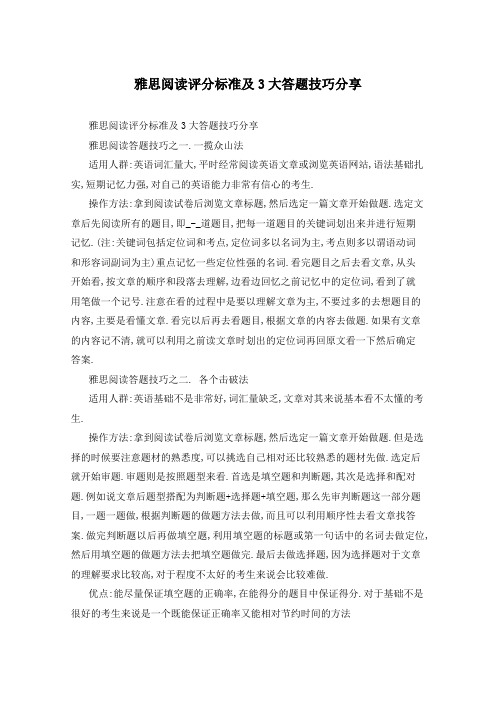
雅思阅读评分标准及3大答题技巧分享雅思阅读评分标准及3大答题技巧分享雅思阅读答题技巧之一.一揽众山法适用人群:英语词汇量大,平时经常阅读英语文章或浏览英语网站,语法基础扎实,短期记忆力强,对自己的英语能力非常有信心的考生.操作方法:拿到阅读试卷后浏览文章标题,然后选定一篇文章开始做题.选定文章后先阅读所有的题目,即_-_道题目,把每一道题目的关键词划出来并进行短期记忆.(注:关键词包括定位词和考点,定位词多以名词为主,考点则多以谓语动词和形容词副词为主)重点记忆一些定位性强的名词.看完题目之后去看文章,从头开始看,按文章的顺序和段落去理解,边看边回忆之前记忆中的定位词,看到了就用笔做一个记号.注意在看的过程中是要以理解文章为主,不要过多的去想题目的内容,主要是看懂文章.看完以后再去看题目,根据文章的内容去做题.如果有文章的内容记不清,就可以利用之前读文章时划出的定位词再回原文看一下然后确定答案.雅思阅读答题技巧之二. 各个击破法适用人群:英语基础不是非常好,词汇量缺乏,文章对其来说基本看不太懂的考生.操作方法:拿到阅读试卷后浏览文章标题,然后选定一篇文章开始做题.但是选择的时候要注意题材的熟悉度,可以挑选自己相对还比较熟悉的题材先做.选定后就开始审题.审题则是按照题型来看.首选是填空题和判断题,其次是选择和配对题.例如说文章后题型搭配为判断题+选择题+填空题,那么先审判断题这一部分题目,一题一题做,根据判断题的做题方法去做,而且可以利用顺序性去看文章找答案.做完判断题以后再做填空题,利用填空题的标题或第一句话中的名词去做定位,然后用填空题的做题方法去把填空题做完.最后去做选择题,因为选择题对于文章的理解要求比较高,对于程度不太好的考生来说会比较难做.优点:能尽量保证填空题的正确率,在能得分的题目中保证得分.对于基础不是很好的考生来说是一个既能保证正确率又能相对节约时间的方法缺陷:时间花费比较多,而且会多次重复阅读文章.雅思阅读答题技巧之三. 融会贯通法适用人群:有一定的英语词汇量,并参加过培训班,掌握了基础语法知识.操作方法:拿到阅读试卷后浏览文章标题和文章后的题型,选择自己最熟悉的话题或者有自己最擅长的题型的那篇文章.然后浏览一下题型,确定下题型关注的先后顺序,也是先填空判断,后配对选择.但这种先后并不是绝对的,而是交替的,也就是在重点做填空判断之前已经将判断选择的定位词和关键词划出并记忆,然后在做填空判断时顺带着看看有没有出现配对题和选择题的定位词出现.如果程度稍好的同学则可以看一段文章,把这段文章中涉及到的各种题型的题目都完成,一段一段解决问题.但是用这种方法的时候要注意时间的把握.优点:可以相对合理的安排时间去做题,也能保证容易做的题型的正确率.缺陷:需要考生能随机应变,对不同的题型搭配要有合理的时间分配,可能会造成审题或看文章内容的混乱.附雅思阅读听力评分标准镇楼雅思阅读小范围预测文章题目Undergraduate students study dramas重复年份__31 _1_8题材人文社科题型暂无文章大意文学专业学生的课程指南,提到了让学生观看英国不同时期剧院中的戏剧, 并列举了不同时期四种剧院的特点.参考阅读:Medieval periodMain article: Medieval theatreBy the medieval period, the mummers plays had developed, a form of earlystreet theatre associated with the Morris dance, concentrating on themes such asSaint George and the Dragon and Robin Hood. These were folk tales re-telling oldstories, and the actors travelled from town to town performing these for theiraudiences in return for money and hospitality.Renaissance: Elizabethan and Jacobean periodsThe period known as the English Renaissance, appro_imately _00—_60, saw aflowering of the drama and all the arts. The two candidates for the earliestcomedy in English Nicholas Udall s Ralph Roister Doister (c. _52) and theanonymous Gammer Gurton s Needle (c. _66), belong to the _th century. Duringthe reign of Elizabeth I (_58–__) and then James I (__–25), in the late_th and early _th century, a London-centred culture, that was both courtly andpopular, produced great poetry and drama. The English playwrights were intriguedby Italian model: a conspicuous community of Italian actors had settled inLondon. The linguist and le_icographer John Florio (_53–_25), whose father wasItalian, was a royal language tutor at the Court of James I, and a possiblefriend of and influence on William Shakespeare, had brought much of the Italianlanguage and culture to England. He was also the translator of Montaigne intoEnglish. The earliest Elizabethan plays includes Gorboduc (_61) by Sackvilleand Norton and Thomas Kyd s (_58–94) revenge tragedy The Spanish Tragedy(_92), that influenced Shakespeare s Hamlet._th and _th centuriesAphra Behn was the first professional English woman playwright.During the Interregnum _49—_60, English theatres were kept closed by thePuritans for religious and ideological reasons. When the London theatres openedagain with the Restoration of the monarchy in _60, they flourished under thepersonal interest and support of Charles II. Wide and socially mi_ed audienceswere attracted by topical writing and by the introduction of the firstprofessionalactresses (in Shakespeare s time, all female roles had been played by boys).New genres of the Restoration were heroic drama, pathetic drama, and Restorationcomedy. Notable heroic tragedies of this period include John Dryden s All forLove (_77) and Aureng-zebe (_75), and Thomas Otway s Venice Preserved (_82).The Restoration plays that have best retained the interest of producers andaudiences today are the comedies, such as George Etherege s The Man of Mode(_76), William Wycherley s The Country Wife (_76), John Vanbrugh s The Relapse(_96), and William Congreve s The Way of the World (_00). This period saw thefirst professional woman playwright, Aphra Behn, author of many comediesincluding The Rover (_77). Restoration comedy is famous or notorious for itsse_ual e_plicitness, a quality encouraged by Charles II (_60–_85) personallyand by the rakish aristocratic ethos of his court.Victorian eraA change came in the Victorian era with a profusion on the London stage offarces, musical burlesques, e_travaganzas and comic operas that competed withShakespeare productions and serious drama by the likes of James Planché andThomas William Robertson. In _55, the German Reed Entertainments began aprocess of elevating the le vel of (formerly risqué) musical theatre in Britainthat culminated in the famous series of comic operas by Gilbert and Sullivan andwere followed by the _90s with the first Edwardian musical comedies. W. S.Gilbert and Oscar Wilde were leading poets and dramatists of the late Victorianperiod.[_] Wilde s plays, in particular, stand apart from the many nowforgotten plays of Victorian times and have a much closer relationship to thoseof the Edwardian dramatists such as Irishman George Bernard Shaw and NorwegianHenrik Ibsen.文章题目Unique golden te_tile重复年份___ ___题材工业题型小标题 6+人名配对 4+填空 3文章大意蜘蛛丝与纺织品.文章讲述了 golden spider 是如何在体内把Liquid silk转化为 solid silk 的过程,文章中提到了一些科学家针对蜘蛛做的实验,如何提高 capacity.在结尾两段讲述了关于 spider silk的医学应用及市场的积极前景.参考答案:小标题:i e_periment of an old ideaii lifecycle of Madagascar spidersiii advances in te_tile industryiv resources to meet demandsv physical property of spider silkvi scientific analysis spider silkvii work of artviii importance of silk te_tilei_ difficult to raise spider in capacity_. Paragraph A viii_. Paragraph B v_. Paragraph C i__. Paragraph Di_. Paragraph E iv_. Paragraph F vii人名配对 4:A. Simon PeersB. Nicholas GodlleyC. Blackledge20. need tremendous spider to make a small amount of spider silk B _ Scientists want qualities of spider silk for medical use A_ Scientists make progress to manufacture spider silk C23 spider silk materials are be of strength A填空 3:24. grow silk by introduce genetic material into bacteria and animals25. Silk come from liquid protein made in a gland inside of bodies.26. Spider silk spins cause force to make liquid turn to solid silk.文章题目 British Woodlands重复年份 __30 ___题材自然环境题型段落细节配对 7+选词填空 7文章大意讲的是英国森林的演变利用和最后的管理,大致文章脉络是在人类的入侵之前英国的植被覆盖情况,工业革命之后,人们对森林的掠夺从以燃烧原料和建筑材料为目的到了以工业发展为目的,后来人们意识到保护森林的重要, 开始投入人力物力进行保护.部分答案参考:段落细节配对:27 a desc ription of careless working practices that harm woodland F28 details of landscape prior to human intervention B29 arguments against cash rewards H30 a botanical source of evidence for the appearance of primitive woodlandB31 reasons for reduced economic importance of woodland E32 a reason for recent improvements of woodland management G33 an implication for people of unhealthy tree A选词填空:Evolution of British WoodlandWhen woodland started to grow after last Ice Age. certain 34. speciesnaturallydominated certain regions of Britain. People then intervened to reduce thewoodland by using grazing animals and methods such as 35. burning and coppicing.An increasing number of trees have been grown to meet the demand of 36.IndustrySituations of woodland in Britain deteriorated due to the use of 37.I andthe rigid38. planting patterns of woodland. Such practices also destroyed the39.habits Gof animals and other wildlife.However, in the twentieth century, the state of woodland in Britain has beenimproved. 40.grants available for fund encourage people to plant trees in goodquality.雅思阅读小范围预测题目:the nature of yawning内容:关于打哈欠传染的研究题型:段落细节匹配5道+特殊词匹配4道+填空4道题号:___文章大意:讲关于打呵欠传染的研究,主要有三个研究机构开展的研究.第一个机构研究发现打呵欠是人类冷却大脑的一种方式.后面两个研究发现打呵欠和个人的性格.同情心.专业背景有关,和性别无关.最后讲了呵欠产生的过程,提到有一种理论讲的是呵欠可能是人类交流的一种方式,用于提醒同伴你累了需要休息,从而要求对方打起精神应对危险.部分答案回忆:_. C imagining leads to yawning_. D occupation and inclination to yawning_. A overview of research_. B body temperature and yawning_. B disapprove of a theory_. B not difference in gender20. C mental disorder 文中定位:autism_. A the way we breathe 文中定位:inhale_. B trained yawn more than the untrained23. bond用来联系人类情感24 danger危险的时候警示别人rest特别是需要休息的时候non-verbal是人类肢体语言的一种题目:the nature of music内容:对音乐的研究,介绍音乐历史和音乐对人类的影响题型:选择4道+段落信息匹配5道+判断5道参考答案:25. C定位词:第一段中的 nature of music ,答案:many elements26. D 定位词:language and music ,答案:STEVE27. A 定位词:Neanderthals 答案:show reactions28. C定位词:Neanderthals and homo sapiens 答案:for partners31 . D 定位词:feature and music ,答案:change in all cultures32. C 定位词:Mithen ,答案:reference for other people33. A定位词:precious research ,答案:limited in the range of research34. E 定位词:power of emotion ,答案:long history35. B 定位词:reviewer disagrees with Mithen ,答案:modem speech 影响音乐36. TRUE most discussion ignore physical factors37. TRUE shared features/small societies/remote areas38. NOT GIVEN people talk to babies/similar to/Neandethals music39. FALSE Mithen support Steve40. NOT GIVEN modem people depend heavily on electronic music题目:Thomas Young ~The Last True Know一It一All题材:人物传记题型:判断7+填空6参考文章:A Thomas Young(_73一_29)contributed 63 articles to the EncyclopediaBritannica, Including 46 Biographical entries(mostly on scientists andclassicists) and substantial essays on Bridge, Chromatics, Egypt, Languages,and Tides Was someone who could write authoritatively about so many subjects apolymath, a genius or a dilettante? In an ambitious new biography, Andrew Robinson argues that Young is a good contender for the epitaph the lastman whoknew everything〞 Young has competition, however: The phrase, which Robinsontakes for his title, also serves as the subtitle of two other recentbiographies: Leonard Warren s _98 life of paleontologist Joseph Leidy(_23一_91) and Paula Findlen s _ book on Athanasius Kircher (__一_80),another polymath.B Young, of course, did more than write encyclopedia entries . He presentedhid first paper to the Royal Society of London at the age of 2O and was electeda Fellow a week after his 2lst birthday. In the paper, Young e_plained theprocess of accommodation in the human eye一on how the eye focuses properly onobjects at varying distances. Young hypothesized that this was achieved bychanges in the shape of the lens. Young also theorized that light traveled inwaves and he believed that, to account for the ability to see in color, theremust be three receptors in the eye corresponding to the three principal colorsto which the retina could respond: red, green, violet. All these hypotheses weresubsequently proved to be correct.C Later in his life, when he was in his forties, Young was instrumental incracking the code that Unlocked the unknown sc ript on the Rosetta Stone,atablet that was found in Egypt by the Napo leonic army in_99.The stonecontains te_t in three alphabets: Greek, something Unrecognizable and Egyptianhieroglyphs. The unrecognizable sc ript is now known as demotic and, as Youngdeduced, is related directly to hieroglyphic. His initial work on this appearedin his Britannica entry on Egypt. In another entry, he coined the termIndo一European to describe the family of languages spoken throughout most ofEurope and northern India. These are the landmark achievements of a man who wasa child prodigy and who,unlike many remarkable children, did not disappear intooblivion as an adult.D Bom in _73 in Somerset in England, Young lived from an early age with hismaternal Grandfather ,eventually leaving to attend boarding school. He haddevoured books from the age of two, and through his own initiative hee_celledat Latin, Greek, mathematics and natural philosophy. After leaving school , hewas greatly encouraged by his mother s uncle, Richard Brocklesby, a physicianand Fellow of the Royal Society. Following Brocklesby lead, Young decided topursue a career in medicine. He studied in London, following the medicalcircuit, and then moved on to more formal education in Edinburgh, G6ttingen andCambridge. After completing his medical training at the University of Cambridgein __, Young set up practice as a physician in London. He soon became a Fellowof the Royal College of Physicians and a few years later was appointed physicianat St. George’s Hospital.E Young’s skill as a physician, however, did not equal his skill as a scholarof natural philosophy or linguistics. Earlier, in __, he had been appointed toa professorship of natural philosophy at the Royal Institution, where hedelivered as many as 60 lectures in a year. These were published in two volumesin __. In __ Young had become secretary to the Royal Society, a post hewould hold until his death. His opinions were sought on civic and nationalmatters, such as the introduction of gas lighting to London and methods of shipconstruction. From __ he was superintendent of the Nautical Almanac andsecretary to the Board of Longitude. From _24 to _29 he was physician to andinspector of calculations for the Palladian Insurance Company. Between __ and_25 he contributed his many and various entries to the Encyclopedia Britannica,and throughout his career he authored numerous books, essays and papers.F Young is a perfect subject for a biography - perfect, but dauntitianhieroglyphs). Some readers of this book will, like Robinson, find Young’saccomplishments impressive; others will see him as some historians have - as adilettante. Yet despite the rich material presented in this book, readers willnot end up knowing Young personally. We catch glimpses of a playful Young,doodling Greek and Latin phrases in his notes on medical lectures and translating the verses that a young lady had written on the walls of a summerhouse into Greek elegiaes. Young was introduced into elite society,attended the theatre and learned to dance and play the flute. In addition, hewas an accomplished horseman. However, his personal life looks pale ne_t to hisvibrant career and studies.G Young married Eliza Ma_well in __, and according to Robinson, theirmarriage was a happy one and she appreciated his work_ Almost all we know abouther is that she sustained her husband through some rancorous disputes aboutoptics and that she worried about money when his medical career was slow to takeoff. Veiy little evidence survives about the comple_ities of Young5s relationships with his mother and father. Robinson does not credit them,oranyone else, with shaping Young5 s e_traordinary mind. Despite the lack ofdetails concerning Young5 s relationships, however, anyone interested in what itmeans to be a genius should read this book.参考答案:Questions 1-7Do the following statements agree with the information given in ReadingPassage 1 ?In bo_es 1 -7 on your answer sheet, write TRUE if the statement is true FALSEif the statement is falseNOT GIVEN if the information is not given in the passage1 The last man who knew everything’ has also been claimed to other people.True2 All Young articles were published in Encyclopedia Britannica. False3 Like others, Young wasn’t so brilliant when grew up. False4 Young talents as a tor are surpassing his other skills. NG5 Young advice was sought by people responsible for local and nationalissues. True6 Young was interested in various social pastimes. True7 Young suffered from a disease in his later years. NGQuestions 8-_Answer the questions below.Choose NO MORE THAN THREE WORDS AND/OR A NUMBER from the passage for eachanswer.8 How many life stories did Young write for Encyclopedia Britannica?469 What aspect of scientific research did Young do in his first academicpaper? Human eye accommodation10 What name did Young introduce to refer to a group of languages?Indo-European_ Who inspired Young to start the medical studies? Richard Brocklesby _ Where did Young get a teaching position? Royal Institution_ What contribution did Young make to London? Gas lighting 雅思阅读评分标准及3大答题技巧分享。
雅思阅读选择题答题方法和技巧深度解析

雅思阅读选择题答题方法和技巧深度解析选择题有两种类型:单项选择题和多项选择题。
多数情况下,选择题都是考察文中的细节信息,但也有少数单项选择题会考察文章的主旨信息。
比方,当一篇文章原本就没有标题的时候,那么这篇文章出的最后一个题目一定是让我们选择文章标题的单项选择题;再比方有时候题目会问到写这篇文章的目的,或者写某个段落的目的。
像这种提问意图的选择题,以及选择文章或段落标题的选择题就是考察主旨的选择题,对于考察主旨的选择题来说,我们在选择答案的时候一定要选择一个最概括的选项来作为答案,那些文章没提到过的或者过于片面的选项都是要排除的选项。
接下来,我们就来分析一下考察细节信息选择题。
多项选择题都是考察细节的选择题。
对于多项选择题来说,题干中的信息一定包含题目的定位信息,所以必须找出题干中的定位词,然后回到原文中扫读包含定位词的语句。
而对于多项选择题的正确选项来说,都是出自定位词所在的段落或者相邻的一两个段落里,不可能相差太远,除非题干中的定位词很明显地出现在比拟远的段落里。
其次,对于考察细节的单项选择题来说,题干信息同样重要,但往往很多在做单项选择题的时候容易忽略掉题干的信息,而是去根据选项的信息去找答案了。
这种做法无疑使得在做单项选择题的时候思路不清,不知道自己该找了,这种时候有的同学就下意识地去选择文中提及过的选项,而忽略的什么样的选项才是能够答复下列问题的选项。
所以,在做任何选择题的时候,第一步永远是看明白题干到底问什么。
第二步,便是从题干中找出定位词,回到原文中扫读包含定位词的语句,但有时候题干的定位词在原文中不明显或者被同义替换,这些时候我们就需要适当的借助选项中比拟容易被找到的特殊词或者重复出现的关键词来辅助定位,需要注意的是根据选项信息定到的位置是选项的对应的原文位置,不一定是正确的选项,所以要找到题目答案,还是要在根据选项定到的位置附近找到题干的位置,通常情况下这才是离正确答案最近的位置。
雅思阅读多选题的答题方法

雅思阅读多选题的答题方法
多选题的解题思路主要从三个步骤:
1.审题
先通过文章的题目或题干的关键词进行判断这个多选题是集中型还是分散型。
集中型,答案一般在一段或者几段中。
分散型,答案很有可能分布在全文。
2定位
一是从文章段落出发,二是从选项出发。
集中型一般根据关键词进行定位原文的段落。
分散型的一般不能根据题干定位,一般通过选项定位。
3.排除
一般简单的可以直接选择。
难题就可以使用排除法确定正确答案。
总结:
雅思阅读的多选题属于出现率不高的题型。
但是多选题一般是一半能拿分,一半拿不了分。
雅思阅读多选题是指题目中会给出一个问题,然后要求考生在给定的文本中找出正确的选项。
以下是一些可以帮助你解答雅思阅读多选题的方法:
仔细阅读问题和选项:在看到多选题之前,一定要先读
问题和选项,这样可以更好地理解题目的要求,也可以帮助你快速定位文章中的相关信息。
找到相关段落:通过阅读文章找到与问题相关的段落,多数情况下,选项与问题会在文章的同一段落中,有时会在相邻的几个段落中出现。
关注关键词:在文章中找到与选项中的关键词相关的段落,例如人名、地名、时间、数字等。
如果选项中包含明确的关键词,那么在阅读文章时要特别注意。
排除干扰项:有时候文章中会出现与选项类似但不是正确答案的内容,这就需要考生通过排除干扰项来确定正确答案。
排除干扰项的方法包括仔细阅读文章中的描述、重点理解选项的细节,并找出选项和文章中的不同点等。
深入理解文章:如果文章中提供了对问题和选项的解释或解释,那么仔细阅读它们可以帮助你更好地理解和回答问题。
雅思阅读选择题的做题思路详解
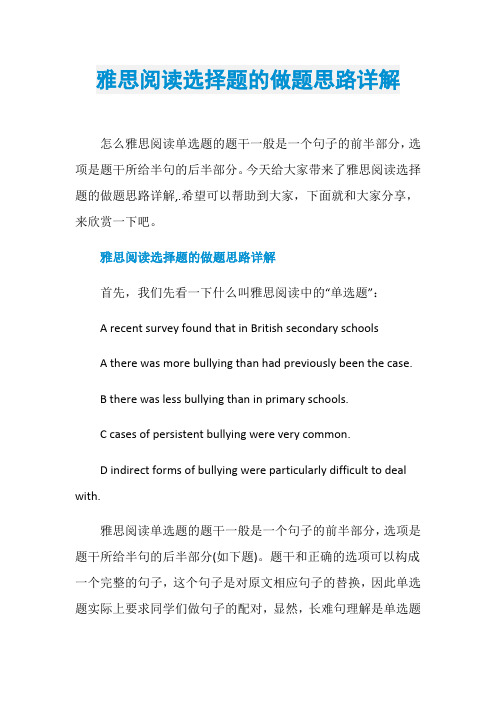
雅思阅读选择题的做题思路详解怎么雅思阅读单选题的题干一般是一个句子的前半部分,选项是题干所给半句的后半部分。
今天给大家带来了雅思阅读选择题的做题思路详解,.希望可以帮助到大家,下面就和大家分享,来欣赏一下吧。
雅思阅读选择题的做题思路详解首先,我们先看一下什么叫雅思阅读中的“单选题”:A recent survey found that in British secondary schoolsA there was more bullying than had previously been the case.B there was less bullying than in primary schools.C cases of persistent bullying were very common.D indirect forms of bullying were particularly difficult to deal with.雅思阅读单选题的题干一般是一个句子的前半部分,选项是题干所给半句的后半部分(如下题)。
题干和正确的选项可以构成一个完整的句子,这个句子是对原文相应句子的替换,因此单选题实际上要求同学们做句子的配对,显然,长难句理解是单选题考察的重点。
而很多同学并不能很好地理解句子,因此会觉得选择题难度比较大。
正确的思维过程做选择题的步骤是:1. 读题、明确定位词。
在读题的时候,同学们只需要去看题干,用题干所给信息进行定位。
如下题:【例题1】A recent survey found that in British secondary schoolsA there was more bullying than had previously been the case.B there was less bullying than in primary schools.C cases of persistent bullying were very common.D indirect forms of bullying were particularly difficult to deal with.【分析】题干问“最近的一个研究发现英国的中学怎么样了”,在题干中提到了具化的概念“英国的中学”,所以这就是我们用来定位的词,回到原文看哪个词或词组表达出了“英国中学”这个概念。
雅思A类阅读考试的常见题型及解题方法

雅思A类阅读考试的常见题型及解题方法雅思A类阅读考试是雅思考试中的一项重要考试,主要测试考生的阅读理解能力。
这项考试的题型与其他国际英语考试相似,但在阅读材料的难度方面更有挑战。
以下是雅思A类阅读考试的常见题型及解题方法。
一、选择题1. 选择正确的单词或短语此类题目要求考生根据阅读材料中提供的上下文和语境,选择正确的单词或短语填入空白处。
考生需要认真阅读材料,并注意上下文中的线索和语境。
解题方法:考生应该先浏览题目,找出空白处需要填入的类型(单词或短语)。
然后,考生应该仔细阅读材料,找到与空白处相对应的上下文和语境,进行匹配。
最后,根据选项,选择正确的答案。
2. 选择正确的答案此类题目要求考生根据阅读材料中的问题和信息,选择正确的答案。
考生需要仔细阅读材料,并注意问题的提出和信息的线索。
解题方法:考生应该先读问题,然后仔细阅读材料,找到与问题相关的信息和线索。
在阅读材料时,考生应该注意问题的提出和信息的线索。
最后,根据选项,选择正确的答案。
二、填空题此类题目要求考生根据阅读材料中提供的上下文和语境,填写正确的单词或短语。
考生需要认真阅读材料,并注意上下文中的线索和语境。
解题方法:考生应该先浏览题目,找出题目中需要填空的词汇类型(单词或短语)。
然后,考生应该仔细阅读材料,找到与空白处相对应的上下文和语境,进行匹配。
最后,根据填空类型,填写正确的答案。
三、匹配题此类题目要求考生根据阅读材料中提供的信息,将问题和答案匹配起来。
考生需要认真阅读材料,并注意问题和答案的相关性和线索。
解题方法:考生应该先浏览题目,找出需要匹配的问题和答案。
然后,考生应该仔细阅读材料,找到与问题和答案相关的信息和线索。
最后,根据问题和答案的相关性和线索,进行匹配。
四、判断题此类题目要求考生根据阅读材料,判断给定的陈述是否属实。
考生需要认真阅读材料,并理解陈述的含义和内容。
解题方法:考生应该先读题,弄清陈述的含义和内容。
然后,考生应该仔细阅读材料,找到与陈述相关的信息和线索。
雅思阅读高分—处理好阅读第一步
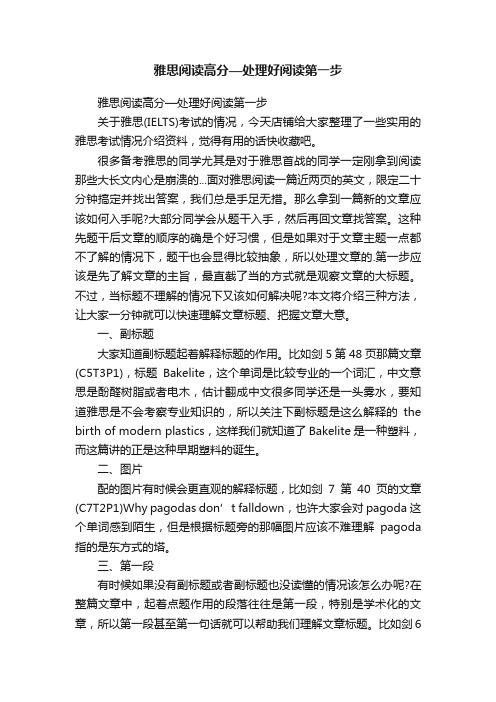
雅思阅读高分—处理好阅读第一步雅思阅读高分—处理好阅读第一步关于雅思(IELTS)考试的情况,今天店铺给大家整理了一些实用的雅思考试情况介绍资料,觉得有用的话快收藏吧。
很多备考雅思的同学尤其是对于雅思首战的同学一定刚拿到阅读那些大长文内心是崩溃的...面对雅思阅读一篇近两页的英文,限定二十分钟搞定并找出答案,我们总是手足无措。
那么拿到一篇新的文章应该如何入手呢?大部分同学会从题干入手,然后再回文章找答案。
这种先题干后文章的顺序的确是个好习惯,但是如果对于文章主题一点都不了解的情况下,题干也会显得比较抽象,所以处理文章的.第一步应该是先了解文章的主旨,最直截了当的方式就是观察文章的大标题。
不过,当标题不理解的情况下又该如何解决呢?本文将介绍三种方法,让大家一分钟就可以快速理解文章标题、把握文章大意。
一、副标题大家知道副标题起着解释标题的作用。
比如剑5第48页那篇文章(C5T3P1),标题Bakelite,这个单词是比较专业的一个词汇,中文意思是酚醛树脂或者电木,估计翻成中文很多同学还是一头雾水,要知道雅思是不会考察专业知识的,所以关注下副标题是这么解释的the birth of modern plastics,这样我们就知道了Bakelite是一种塑料,而这篇讲的正是这种早期塑料的诞生。
二、图片配的图片有时候会更直观的解释标题,比如剑7第40页的文章(C7T2P1)Why pagodas don’t falldown,也许大家会对pagoda这个单词感到陌生,但是根据标题旁的那幅图片应该不难理解pagoda 指的是东方式的塔。
三、第一段有时候如果没有副标题或者副标题也没读懂的情况该怎么办呢?在整篇文章中,起着点题作用的段落往往是第一段,特别是学术化的文章,所以第一段甚至第一句话就可以帮助我们理解文章标题。
比如剑6第93的文章(C6T4P3),通过副标题我们可以知道文章的主题是孩子面临的bullying问题,但bullying到底是什么意思呢,副标题并没有解释,那就让我们看一下第一段的第一句话:Bullying can take a variety of forms, from the verbal – being taunted or called hurtfulnames – to the physical – being kicked of shoved – as well as indirect forms, such as beingexcluded from social groups.这句话讲了bullying的三种形式:verbal,physical和indirect forms。
雅思阅读各题型4个技巧亲授
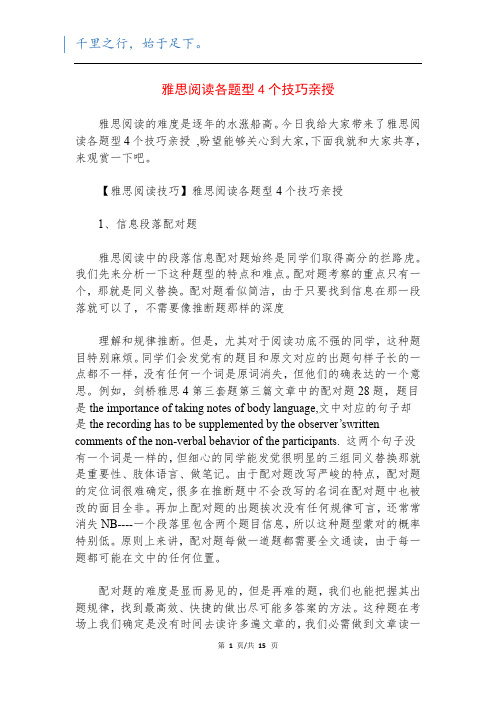
雅思阅读各题型4个技巧亲授雅思阅读的难度是逐年的水涨船高。
今日我给大家带来了雅思阅读各题型4个技巧亲授,盼望能够关心到大家,下面我就和大家共享,来观赏一下吧。
【雅思阅读技巧】雅思阅读各题型4个技巧亲授1、信息段落配对题雅思阅读中的段落信息配对题始终是同学们取得高分的拦路虎。
我们先来分析一下这种题型的特点和难点。
配对题考察的重点只有一个,那就是同义替换。
配对题看似简洁,由于只要找到信息在那一段落就可以了,不需要像推断题那样的深度理解和规律推断。
但是,尤其对于阅读功底不强的同学,这种题目特别麻烦。
同学们会发觉有的题目和原文对应的出题句样子长的一点都不一样,没有任何一个词是原词消失,但他们的确表达的一个意思。
例如,剑桥雅思4第三套题第三篇文章中的配对题28题,题目是the importance of taking notes of body language,文中对应的句子却是the recording has to be supplemented by the observer’swritten comments of the non-verbal behavior of the participants. 这两个句子没有一个词是一样的,但细心的同学能发觉很明显的三组同义替换那就是重要性、肢体语言、做笔记。
由于配对题改写严峻的特点,配对题的定位词很难确定,很多在推断题中不会改写的名词在配对题中也被改的面目全非。
再加上配对题的出题挨次没有任何规律可言,还常常消失NB----一个段落里包含两个题目信息,所以这种题型蒙对的概率特别低。
原则上来讲,配对题每做一道题都需要全文通读,由于每一题都可能在文中的任何位置。
配对题的难度是显而易见的,但是再难的题,我们也能把握其出题规律,找到最高效、快捷的做出尽可能多答案的方法。
这种题在考场上我们确定是没有时间去读许多遍文章的,我们必需做到文章读一遍,全部的题目就处理完了。
雅思阅读9分攻略

雅思阅读9分攻略雅思阅读9分是许多人梦寐以求的满分了,下面小编给大家带来雅思阅读9分攻略,希望你就是下一个9分达人!雅思阅读9分攻略在这里ZZ要插一句话,其实阅读上了7.5之后,你的分数到底是多少,就有一些运气成分了因为能拿到7.5的小伙伴要么就是基础特别好,真的看得懂要么就是技巧特别好,做的特别顺所以..小伙伴们一定要先拼一个7或者7.5,然后可以奔着更高的分去努力我这次阅读准备过程主要就是跟着ZZ的打卡群刷剑10和11,自己也做了点题(很少最多就十多篇):用的是9分达人和其他的一些资料。
阅读比较基本的(每天要做的)东西就是单词和538,我比较懒了…538过了几遍,但是完全没记全…然后我有一张生词纸(对,很惭愧。
不是本,是一张A4纸)把每篇阅读碰到的答案句和题干生词摘出来,然后我发现有很多词雅思超级爱考,这些词不一定是答案词或者替换词,但影响我理解的词,永远在这一张纸上。
我想多写点都写不出来了,就那些词,我错永远是因为他们。
从这个角度来说,我觉得雅思阅读是真的很善良,不用像托福和GMAT那样疯狂背词,你只要找到自己的问题根源提分是很快的。
我觉得对大多数想上6.5的考生来说,原文中生词肯定是很多很多的,把所有生词找出来很耗时间,对短时间提分也不太有效,所以只找答案句和题干以及影响阅读的生词就好了,比较省时间,而且见效快。
有基础打底之后,练习也要跟上。
每个人的瓶颈都不太一样,到底是哪里出了问题怎么去治,我觉得这个还是要靠自己去“诊断”。
速度慢就练打包做题和自己对文章的信息概括,每一段自己总结一个summary,然后再对照答案看自己和答案总结的哪里不一样,时间久了就能感受到雅思的套路了,因为毕竟自己想法和雅思阅读考试是有偏差的,尽管有时候自己想的不错,但考雅思,你要遵循雅思的规则和逻辑,他说哪个对,你就选哪个。
我本身的阅读速度不慢,主要问题是正确率不太高。
所以我是逐个题型去攻破的,先保证填空题基本不错,然后是“”进阶版填空“:”TFNG和单选,其实这三项保证正确率的话阅读6.5肯定就有了,这三项靠刘洪波老师的阅读真经和538找同替就可以做到,不需要动脑子不需要自己想,找原文答案就行了。
雅思阅读选择题的解题技巧

雅思阅读选择题的解题技巧雅思阅读选择题的解题技巧雅思阅读中的选择题有两种主要形式:一种是四选一,即传统概念上的单项选择题, (Multiple choice) 另一种是多选多 (Pick from a list) ,即通常所理解的多项选择题,它的选择项至少为5个,选出的答案至少有2个。
虽然形式有所不同,但这两种题型的做题方法的技巧都是一样的。
首先,我们一起来看一下选择题的题型特点:1. 题目间有顺序原则跟绝大多数题型一样,选择题的题号之间都基本遵循顺序原则。
这意味着一旦一道题目定位不出来,可以根据相邻的题目,把范围推出来。
2. 考察内容多为细节除了通常位于文章末尾的 Global multiple choice 题型考察考生对全文大意的理解之外,其余的都是要建立在对文章细节的理解之上的。
做这种题型时,考生没有必要对全文进行通读进行理解,而只需要对文章的一句话或者是几句话进行理解便可。
3. 多项选择题答案集中纵观雅思所有的真题,不难发现绝大多数多项选择题的答案都是出现在1-2个小段之内(最多不超过4段),而不是分散在全文。
考生只要定位到了相关的段落并进行略读,根据语言转换便不难找到答案。
4. 选择项都有较大的同义转换雅思阅读在很大程度上就是考察考生的语言水平,而这一步是通过题目跟文章的语言转换进行的。
语言转换主要通过同义词和同义句型来实现,而在选择题中,由于选项绝大多数都是一个短语,不是完整的句子,因此语言转换主要是通过同义词来进行的。
现在我们就来一起看一下选择题的.做题步骤。
I. 阅读指令 (Instruction)这一步骤主要是针对多项选择而言的。
单项选择题的指令没有任何作用,可以忽略不看。
而在多项选择题中,指令中会提示正确选项的数量。
在誊写答题卡的时候,一定要注意多项选择题的题号,一个正确选项占用一个题号。
这一点对于初次接触雅思的考生来说要特别引起注意。
II. 阅读题干,划出定位词由于选择题考察细节的特点,故题干中的词往往能够提供定位,方便考生在文章中把所对应的句子或段落找出来。
冲高分必备,雅思阅读超实用技巧!
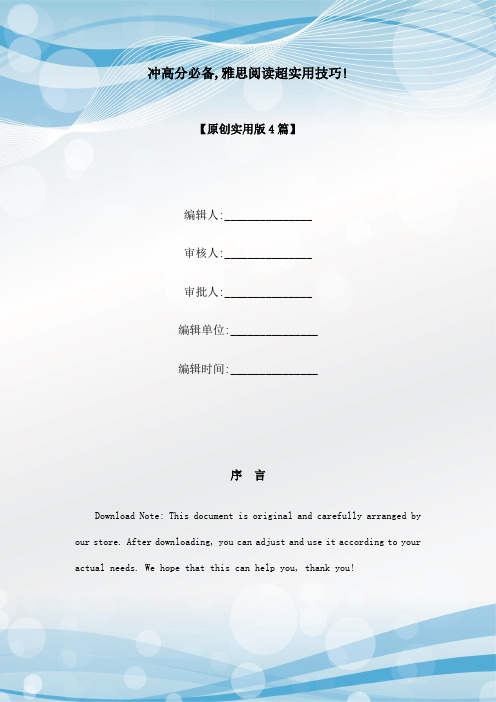
【原创实用版4篇】编辑人:_______________审核人:_______________审批人:_______________编辑单位:_______________编辑时间:_______________序言Download Note: This document is original and carefully arranged by our store. After downloading, you can adjust and use it according to your actual needs. We hope that this can help you, thank you!(4篇)《冲高分必备,雅思阅读超实用技巧!》篇1雅思阅读是备考中的重要部分,以下是一些实用的技巧:1. 熟悉考试格式和题型:了解雅思阅读考试的格式和题型,包括文章类型、题目类型和答案类型等,可以帮助你更好地应对考试。
2. 培养以获取信息为目的的阅读习惯:雅思阅读是一个语言知识和能力为工具达到获取有用信息的过程,所以要注重培养以获取信息为目的的阅读习惯。
3. 提高阅读速度和理解能力:雅思阅读要求在一个小时能阅读三篇文章,完成四十道题目,对阅读速度和对文章的理解能力是有着较高要求的,因此要平时多练习,提高阅读速度和理解能力。
4. 做题技巧:对于不同类型的题目,要有相应的做题技巧,如填空题要认真判断答案词的词性和各种特征,选择题要注意题目中的关键词和句子结构等。
5. 练习同替整理:同替整理是指将同一类型的题目进行分类整理,从而更好地理解和记忆题目的解题方法。
6. 多做真题:多做雅思阅读真题,可以更好地了解考试的难度和题型,提高答题效率和准确率。
《冲高分必备,雅思阅读超实用技巧!》篇2雅思阅读是备考中的重要部分,以下是一些实用的技巧:1. 熟悉考试格式和题型:了解雅思阅读考试的格式和题型,包括文章类型、题目类型和答案类型等,可以帮助你更好地应对考试。
雅思阅读单选题答题技巧分享

雅思阅读单选题答题技巧分享只有掌握了窍门才可能是雅思考试道路上领跑者!实例讲解雅思阅读单选题答题技巧单选题一直是童鞋们认为比较好做的雅思阅读题目,分享雅思阅读单选题型例题讲解,大家在备考雅思阅读单选题型时可以根据以下所提到的阅读技巧进行适当的练习,下面是小编给大家整理收集的雅思阅读单选题答题技巧,供大家参考,希望可以帮到大家!雅思阅读单选题答题技巧单选题一直是童鞋们认为比较好做的雅思阅读题目,其原因无非就是单选题是自打咱小时候开始接触这门外语以外阅读部分的固定题型,闭着眼都能蒙对好几道。
更有童鞋们总结出“三长一短选最长,三短一长选最短,长长短短选二B, 参差不齐选4D” 的金科玉律,醒世良言。
然而,真正研究过雅思阅读的同学会发现,其实单选题,是个会“说谎”的题目,就是说它总是给你错误的感觉让你觉得自己选的很对,其实则不然。
举个简单的例子来说明:33. the writer thinks that the declaration "There is no bullying at this school"A: is no longer true in many schoolsB: was not in fact made by many schoolC: reflected the school's lack of conernD: reflected a lack of knowledge and resources“there is no bullying at this school" has been a common refrain, almost certainly untrue. Fortunately, more schools are now saying: "there is not much bullying here, but when it occurs we have a clear policy for dealing with it."很多同学一看这个题目就直接选了A,选A 选的心甘情愿,义无反顾。
膜拜!雅思阅读两大高分技巧

膜拜!雅思阅读两大高分技巧面对雅思阅读考试,我们要如何进行我们的备考计划才能提高雅思阅读成绩呢?天道留学小编为大家总结出两大雅思阅读高分技巧,下面为大家详细介绍一下,供大家参考,希望对您雅思阅读考试有所帮助,大家想了解更多信息,请关注天道留学。
天道留学小编为了帮助大家提高雅思阅读成绩,下面为大家分享一下两大雅思阅读高分技巧,希望对您雅思阅读考试有所帮助。
1.有差别的阅读,有的放矢雅思考试中的阅读和国内考试中的阅读很多的不同点,比如文章的来源,文章的长度,题型的设置等。
单从前两个区别来看,以前大家从头看到尾,一览众山的方法行不通。
雅思阅读文的学术性导致了文章的深度,在短短20分钟的时间,就算是消化一篇1000多字的中文的学术类文章都会有困难,更何况我们还要完成平均每篇文章十几道题的题量。
但是这并不意味着这种类型的阅读我们是完全hold不住的。
著名大师培根在《论读书》中有这么几句话:Some books areto be tasted, others to be swallowed, and some few to be chewed and digested;that is, some books are to be read only in parts; others to be read, but notcuriously; and some few to be read wholly, and with diligence and attention. 意思就是说:书有可浅尝者,有可吞食者,少数则须咀嚼消化。
换言之,有只须读其部分者,有只须大体涉猎者,少数则须全读,读时须全神贯注,孜孜不倦。
这几句话用在阅读中是再恰当不过,说得更加直白一些,就是有差别的阅读。
在阅读中,我们的目标不是为了赏析文章,而是为了找到我们所需要的信息,然后分析信息,最后获得答案。
分析雅思阅读的所有题型,除了list of headings题型以外,其它题型中的绝大部分题目都是细节题,都是可以在原文中找到一个具体的点来对应。
雅思阅读做题的方法和技巧

雅思阅读做题的方法和技巧想要在雅思考试中拿到高分,就需要在雅思阅读上取得高分,对于雅思的阅读考试,有哪些做题的方法和技巧呢?接下来为大家分享有关解题的方法,来看看吧!1. 浏览文章,观察题目题型组合和数量,判断文章类型拿到文章后,建议考生先不要立马直接做题,而是先观察一下文章里有哪些题型,并且关注一下题目数量,判断是哪一种类型的文章,并且预估考点在文章中的分布情况。
2. 划出所有题目的定位词,判断题目难易划定位词肯定是每位考生都会做的,但是很多考生都是定位一题做一题,再去划下一题的定位词。
这种做法既浪费时间,也不能很好地运用到顺序原则,更不能帮助考生快速判断题目定位难度。
所以这种划定位词的做法是不可取的。
阅读题目中的定位词可以分为两种,一种是明显定位词,一种是非明显定位词。
明显定位词主要以突出的、不易被替换的词为主,如大写的人名、地名、数字、带有特殊符号的词等等。
这种词很显眼,考生可以在文章中快速找到。
与之相对的是非明显定位词,主要是比较不突出的,容易被替换的词。
这种词由于本身既没有被大写,又是普通的名词、动词或形容词,所以很容易被替换,所以考生会比较难定位。
所以,建议考生先划出所有题目的定位词,判断各题目定位难度后,才能更好地利用顺序原则确定大致出题范围。
3. 先做好定位的,容易解答的;再做难定位的,难解答的在观察完题型,划出所有题目定位词后,考生会对各题型和题目难度做大致判断。
建议考生先去做容易定位到,和难度较小的题目,再去做比较难找,或者难解答的题目。
这样才可以在基础题上快速得分,保证正确率,避免在难题上浪费太多时间。
4. 时刻注意题目之间的联系阅读考题中常常会出现考点重合的情况。
所以考生在做题时要不断注意题目之间的联系,一旦发现考点重合的几道题,可以放在一起做。
1. 词汇树词汇树可以为你提供一个语境。
当你绘制出词汇树时,你会发现自己开始对词汇群进行思考。
当你看见一个杯子时,脑海中就会很快想到相关词语,如knife(小刀),fork(叉子),plate(碟子),dishes(餐具)等词。
雅思a类阅读8种主要题型技巧总结

6. 对于第一种匹配题型可以将最难的题留在最后进行匹配,不要在较难的题上花费更多的时间,而应选择较易回答的题目进行匹配,最后所剩即为该难题的答案。
7. 要仔细检察答案,特别是第一题型,因为答错一题,就意味着答错两道题。
雅思a类阅读8种主要题型技巧总结
雅思a类阅读8种主要题型技巧总结
雅思阅读考试的实战技巧
(一)、合理安排答题时间
在IELTS测试过程中,每组题都给有答题参考时间,当所给时间结束时,就一定要停下来,即使这组题没有做完也要开始回答下一组题,否则所能完成的题数就会减少,从而影响IELTS的得分。测试中,应尽可能快速阅读所给指引(DIRECTION),例句(EXAMPLE),及问题(QUESTION)三个部分,并准确理解,从而争取到更多时间来答题。切记不可为了节省时间而忽视查看指引部分,因为指引部分包含了理解题型、回答问题过程中至关重要的信息,如阅读文章的内容,要回答什么问题,及何种问题。当然,也不可以读的太慢,否则也会占用太多回答问题的时间。
2. 确切理解问句的含义,严格按照文章本身意思理解和推断,不要想当然。
3. 找出问句中的关键词语。
4. 利用关键词语在文章中确定答案位置。
5. 仔细查看文章中关键词语所在句子中的含义。必要时应查看关键词语所在句子前后句子的含义。认真区分FALSE和NOT GIVEN,FALSE与原文相反、相冲突;NOT GIVE则不相冲突,但未提及。
(二)、阅读所给文章前要先看问题
首先查看试题布局:
1 阅读试题每一部分的开头与结尾;
2 每部分有多少道题;
3 每部分(或每组题)的答题时间;
Байду номын сангаас4 先回答那些问题。
雅思阅读考试做题技巧
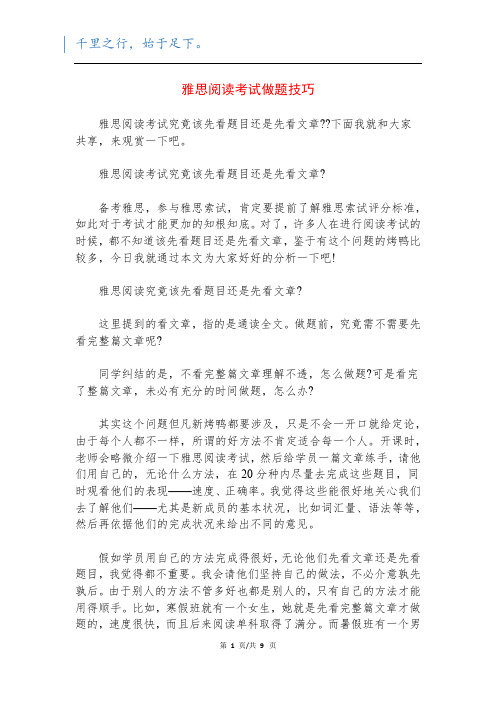
雅思阅读考试做题技巧雅思阅读考试究竟该先看题目还是先看文章??下面我就和大家共享,来观赏一下吧。
雅思阅读考试究竟该先看题目还是先看文章?备考雅思,参与雅思索试,肯定要提前了解雅思索试评分标准,如此对于考试才能更加的知根知底。
对了,许多人在进行阅读考试的时候,都不知道该先看题目还是先看文章,鉴于有这个问题的烤鸭比较多,今日我就通过本文为大家好好的分析一下吧!雅思阅读究竟该先看题目还是先看文章?这里提到的看文章,指的是通读全文。
做题前,究竟需不需要先看完整篇文章呢?同学纠结的是,不看完整篇文章理解不透,怎么做题?可是看完了整篇文章,未必有充分的时间做题,怎么办?其实这个问题但凡新烤鸭都要涉及,只是不会一开口就给定论,由于每个人都不一样,所谓的好方法不肯定适合每一个人。
开课时,老师会略微介绍一下雅思阅读考试,然后给学员一篇文章练手,请他们用自己的,无论什么方法,在20分种内尽量去完成这些题目,同时观看他们的表现——速度、正确率。
我觉得这些能很好地关心我们去了解他们——尤其是新成员的基本状况,比如词汇量、语法等等,然后再依据他们的完成状况来给出不同的意见。
假如学员用自己的方法完成得很好,无论他们先看文章还是先看题目,我觉得都不重要。
我会请他们坚持自己的做法,不必介意孰先孰后。
由于别人的方法不管多好也都是别人的,只有自己的方法才能用得顺手。
比如,寒假班就有一个女生,她就是先看完整篇文章才做题的,速度很快,而且后来阅读单科取得了满分。
而暑假班有一个男生,他就是先看题目再去做题的,速度也很快,后来雅思阅读也考了满分。
如果自己有方法,就能更有效率,何必介怀我的做法与别人的不同呢?不过,假如你没有那么厉害的词汇量、不凡的理解力,而且依据自己的方法做得不如意,或者自己根本就没有概念应当怎么做,then we are ready to help you. 做阅读题时,大部分的学员在有限的时间内,假如先看完文章再做题目通常无法精确地达到目的,而且大多数题目并不需要通读全文。
雅思阅读技巧选择题篇
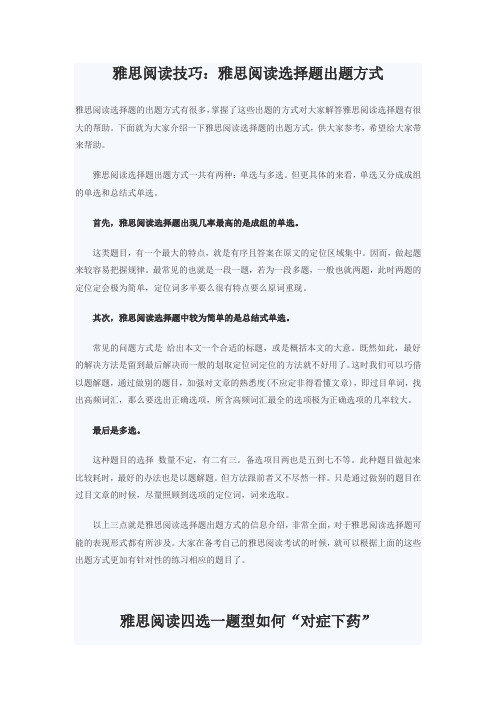
雅思阅读技巧:雅思阅读选择题出题方式雅思阅读选择题的出题方式有很多,掌握了这些出题的方式对大家解答雅思阅读选择题有很大的帮助。
下面就为大家介绍一下雅思阅读选择题的出题方式,供大家参考,希望给大家带来帮助。
雅思阅读选择题出题方式一共有两种:单选与多选。
但更具体的来看,单选又分成成组的单选和总结式单选。
首先,雅思阅读选择题出现几率最高的是成组的单选。
这类题目,有一个最大的特点,就是有序且答案在原文的定位区域集中。
因而,做起题来较容易把握规律。
最常见的也就是一段一题,若为一段多题,一般也就两题,此时两题的定位定会极为简单,定位词多半要么很有特点要么原词重现。
其次,雅思阅读选择题中较为简单的是总结式单选。
常见的问题方式是给出本文一个合适的标题,或是概括本文的大意。
既然如此,最好的解决方法是留到最后解决而一般的划取定位词定位的方法就不好用了。
这时我们可以巧借以题解题,通过做别的题目,加强对文章的熟悉度(不应定非得看懂文章),即过目单词,找出高频词汇,那么要选出正确选项,所含高频词汇最全的选项极为正确选项的几率较大。
最后是多选。
这种题目的选择数量不定,有二有三。
备选项目两也是五到七不等。
此种题目做起来比较耗时,最好的办法也是以题解题。
但方法跟前者又不尽然一样。
只是通过做别的题目在过目文章的时候,尽量照顾到选项的定位词,词来选取。
以上三点就是雅思阅读选择题出题方式的信息介绍,非常全面,对于雅思阅读选择题可能的表现形式都有所涉及。
大家在备考自己的雅思阅读考试的时候,就可以根据上面的这些出题方式更加有针对性的练习相应的题目了。
雅思阅读四选一题型如何“对症下药”一、判断作者的观点或意图我们经常能遇到选择题中有这样的问法:What is the writer’s main point about…? 或者The writer suggests …to illustrate…还有What does the writer say about…? 我们把这些问法归类为判断作者观点或意图的题目。
学为贵雅思阅读高分分享
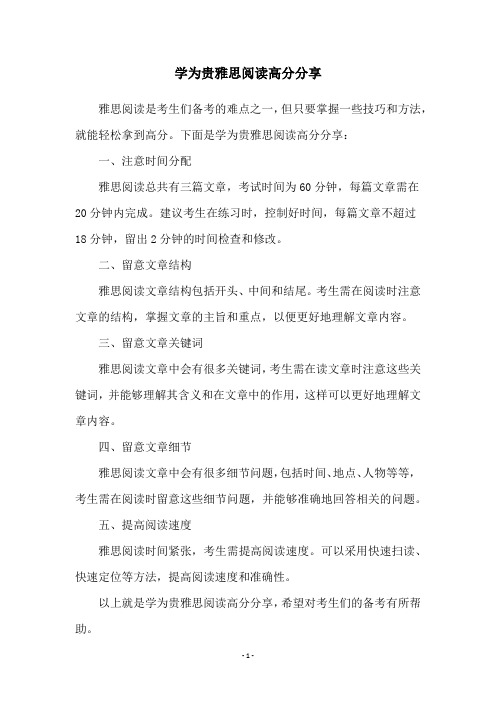
学为贵雅思阅读高分分享
雅思阅读是考生们备考的难点之一,但只要掌握一些技巧和方法,就能轻松拿到高分。
下面是学为贵雅思阅读高分分享:
一、注意时间分配
雅思阅读总共有三篇文章,考试时间为60分钟,每篇文章需在20分钟内完成。
建议考生在练习时,控制好时间,每篇文章不超过
18分钟,留出2分钟的时间检查和修改。
二、留意文章结构
雅思阅读文章结构包括开头、中间和结尾。
考生需在阅读时注意文章的结构,掌握文章的主旨和重点,以便更好地理解文章内容。
三、留意文章关键词
雅思阅读文章中会有很多关键词,考生需在读文章时注意这些关键词,并能够理解其含义和在文章中的作用,这样可以更好地理解文章内容。
四、留意文章细节
雅思阅读文章中会有很多细节问题,包括时间、地点、人物等等,考生需在阅读时留意这些细节问题,并能够准确地回答相关的问题。
五、提高阅读速度
雅思阅读时间紧张,考生需提高阅读速度。
可以采用快速扫读、快速定位等方法,提高阅读速度和准确性。
以上就是学为贵雅思阅读高分分享,希望对考生们的备考有所帮助。
雅思阅读题型解题小技巧

雅思阅读题型解题小技巧我给大家带来了4大雅思阅读题型解题小技巧?你了解了吗。
下面我就和大家共享,来观赏一下吧。
4大雅思阅读题型解题小技巧雅思阅读题型之list of heading⑴依据topic sentence解题是比较重要的方法之一。
因而要留意阅读每一段落的topic sentence.(句首、句中或句尾。
一般在句首的可能性较大,因而对每一段的句首句要重点阅读。
它不仅会给出整个段落的大意,还会解释本段落与上一段落之间的规律联系)。
⑴与summary题一样,雅思阅读list of heading中的备选项一般多于答案的数量,这就意味着一个段落可以有几个符合的备选项,同样先把符合这个段落的备选项挑出来,缩小选择的范围,再从中选择会简单一些。
⑴与雅思阅读multiple choice 题一样,雅思阅读list of heading题的正确答案肯定包含文章的要点(关键词、中心词),由于题目考查的就是段落的大意。
所以,虽然有些备选项的内容是正确的,在文章中也有提及,但却是文章中的细节,而不是大意,就应舍去。
⑴文章段落中所给的example肯定不会是雅思阅读题型之list of heading题的答案,由于它们只是对段落中主要观点的解释说明,并不全面系统,是片面的。
雅思阅读题型之matching⑴ 在雅思阅读matching题中并不是全部的备选项都适合每一个题目,换言之,备选项中只有特定的一部分选项是符合特定的题目的。
所以在做题的时候可以先把符合该题干的备选项挑出来,缩小选择的范围,再去解题。
解题的时候最好选用的方法是排解法。
(如剑3的其次篇阅读)⑴在雅思阅读matching题中肯定要留意问的问题是涉及主观方面的还是客观方面的。
所谓主观方面是指别人的观点、建议、设想等;而所谓客观方面是指事实、介绍、指导等。
⑴看清题序,对号入座。
雅思matching题,尤其是图片matching 题,肯定要留意,所给图示的挨次标号不肯定与原文中的叙述挨次相全都。
- 1、下载文档前请自行甄别文档内容的完整性,平台不提供额外的编辑、内容补充、找答案等附加服务。
- 2、"仅部分预览"的文档,不可在线预览部分如存在完整性等问题,可反馈申请退款(可完整预览的文档不适用该条件!)。
- 3、如文档侵犯您的权益,请联系客服反馈,我们会尽快为您处理(人工客服工作时间:9:00-18:30)。
雅思阅读选择题如何拿高分雅思阅读选择题想拿高分?你得看这个,下面给大家带来了雅思阅读选择题如何拿高分,希望能够帮助到大家,下面就和大家分享,来欣赏一下吧。
雅思阅读选择题想拿高分?你得看这个选择题有两种类型:单选题和多选题。
多数情况下,选择题都是考察文中的细节信息,但也有少数单选题会考察*的主旨信息。
比如,当一篇*原本就没有标题的时候,那么这篇*出的最后一个题目一定是让我们选择*标题的单选题;再比如有时候题目会问到写这篇*的目的,或者写某个段落的目的。
像这种提问意图的选择题,以及选择*或段落标题的选择题就是考察主旨的选择题,对于考察主旨的选择题来说,我们在选择答案的时候一定要选择一个最概括的选项来作为答案,那些*没提到过的或者过于片面的选项都是要排除的选项。
接下来,我们就来分析一下考察细节信息选择题。
多选题都是考察细节的选择题。
对于多选题来说,题干中的信息一定包含题目的定位信息,所以必须找出题干中的定位词,然后回到原文中扫读包含定位词的语句。
而对于多选题的正确选项来说,都是出自定位词所在的段落或者相邻的一两个段落里,不可能相差太远,除非题干中的定位词很明显地出现在比较远的段落里。
其次,对于考察细节的单选题来说,题干信息同样重要,但往往很多同学在做单选题的时候容易忽略掉题干的信息,而是去根据选项的信息去找答案了。
这种做法无疑使得在做单选题的时候思路不清,不知道自己该找什么了,这种时候有的同学就下意识地去选择文中提及过的选项,而忽略的什么样的选项才是能够回答问题的选项。
所以,在做任何选择题的时候,第一步永远是看明白题干到底问什么。
第二步,便是从题干中找出定位词,回到原文中扫读包含定位词的语句,但有时候题干的定位词在原文中不明显或者被同义替换,这些时候我们就需要适当的借助选项中比较容易被找到的特殊词或者重复出现的关键词来辅助定位,需要注意的是根据选项信息定到的位置是选项的对应的原文位置,不一定是正确的选项,所以要找到题目答案,还是要在根据选项定到的位置附近找到题干的位置,通常情况下这才是离正确答案最近的位置。
这就是为什么有时候做选择题需要读的可能是*中定位词出现的位置附近的几句话,而非仅仅定位词所在的句子了。
在做选择的过程中,无非就是两种方法:直选法和排除法。
不管用哪种方法,只要能快速准确的做出题目就好,当直选难以选出正确答案的时候,我们就去用排除法排除错误答案,这样剩下的便是正确的选项了。
那么,什么样的选项会是错误选项呢?我们把错误选项分为四类:1、选项中的关键词在原文中未提及或者判断不出选项信息是否和原文信息一致的情况下,该选项是错误的。
换句话说,如果把每个选项当成判断题来做,那么判断出答案是NOT GIVEN,这样的选项便是错误选项,需要排除。
2、选项信息和原文信息相抵触的情况下,该选项是错误选项,需要排除。
3、当选项信息和原文信息一致,但选项信息却无法回答题干问题的情况下,即使是和原文一致的信息也是错误的,需要排除。
4、最后一种情况也是最容易被错选的:当选项中的关键词信息非常明显地在定位词出现的位置附近出现了,这样的选项只能是部分信息和原文一致,而我们要选出的正确选项一定是全部信息都得和原文一致的并且能够回答题干问题的信息才是正确的信息。
所以这种部分信息一致,但整体却不一定一致的选项也是错误的,需要排除。
最后,希望大家在读了这篇*之后,试着用上文中所提到的一些做题技巧,在之后做选择题的时候,思路能够更清晰,做题能够更快速、更准确雅思阅读机经真题解析-纸张和电脑Paper or Computer?A Computer technology was supposed to replace paper. But that hasnt happened. Every country in the Western world uses more paper today, on a per-capita basis, than it did ten years ago. The consumption of uncoated free-sheet paper, for instance — the most common kind of office paper — rose almost fifteen per cent in the United States between 1995 and 2000 This is generally taken as evidence of how hard it is to eradicate old, wasteful habits and of how stubbornly resistant we are to the efficiencies offered by computerization. A number of cognitive psychologists and ergonomics experts, however, dont agree Paper has persisted, they argue, for very good reasons: when it comes to performing certain kinds of cognitive tasks, paper has many advantages over computers The dismay people feel at the sight of a messy desk — or the spectacle of air-traffic controllers tracking fj through notes scribbled on paper strips — arises from a fundamental confusion about the role that paper plays in our lives.B The case for paper is mode most eloquently in "The Myth of the Paperless Office", by two social scientists. Abigail Sellen and Richard Harper. They begin their book with an account of a study they conducted at the International Monetary Fund, in Washington.D.C. economists at the I.M.F. spend most of their time writing reports on complicated economic questions, work that would seem to be perfectly suited to sitting in front of a computer. Nonetheless, the I.M.F. is awash in paper, and Sellen and Harper wanted to find out why. Their answer is that the business of reports — at least at the I M F. — is an intensely collaborative process, the professional judgments and contributions of many people. The economists bring drafts of reports to conference rooms, spread out the relevant pages, and negotiate changes with one other. They go back to their offices and jot down comments in the margin, taking advantage of the freedom offered by the informality of the handwritten note. Then they deliver the annotated draft to the author in person, taking him, page by page, through the suggested changes. At the end of the process, the author spreads out all the pages with comments on his desk and starts to enter them on the computer —moving the pages around as he works, organizing and reorganizing, saving and discarding.C Without paper, this kind of collaborative and iterative work process would be much more difficult. According to Sellen and Harper, paper has a unique set of "affordances" — that is, qualities that permit specific kinds of uses. Paper is tangible: we can pick up a document, flip through it, read little bits here and there, and quickly get a sense of it. Paper is spatially flexible, meaning that we can spread it out and arrange it in the way that suits us best. And its tailorable: we can easily annotate it, and scribble on it as we read, without altering the original text. Digital documents, of course, have their own affordances. They can be easily searched, shared, stored, remotely, and linked to other relevant material. But they lack the affordances that really matter to a group of people working together on a report. Sellen and Harper write:D Paper enables a certain kind of thinking. Picture, for instance, the top of your desk. Chances are that you have a keyboard and a computer screen off to one side, and a clear space roughly eighteen inches square in front of your chair. What covers the rest of the desktop is probably piles — piles of papers, journals, magazines, binders, postcards, videotapes, and all the other artifacts of the knowledge economy. The piles look like o mess, but they arent. When a group at Apple Computer studied piling behavior several years ago, they found that even the most disorderly piles usuallymake perfect sense to the piles, and that office workers could hold forth in great detail about the precise history and meaning of their piles. The pile closest to the cleared, eighteen-inch-square working area, for example, generally represents the most business, and within that pile the most important document of all is likely to be at the top. Piles are living, breathing archives. Over time, they get broken down and resorted, sometimes chronologically and sometimes thematically and sometimes chronologically and thematically; clues about certain documents may be physically embedded in the file by, say, stacking a certain piece of paper at an angle or inserting dividers into the stack.E But why do we pile documents instead of filing them? Because piles represent the process of active, ongoing thinking. The psychologist Alison Kidd, whose research Sellen and Harper refer to extensively, argues that "knowledge workers" use the physical space of the desktop to hold "ideas which they cannot yet categorize or even decide how they might use" The messy desk is not necessarily a sign of disorganization. It may be a sign of complexity: those who deal with many unresolved ideas simultaneously cannot sort and file the papers on their desks, because they havent yet sorted and filed the ideas in their head. Kidd writes that many of the people she talked to use the papers ontheir desks as contextual cues to "recover a complex set of threads without difficulty and delay" when they come in on a Monday morning, or after their work has been interrupted by a phone call. What we see when we look at the piles on our desks is, in a sense, the contents of our brains.F This idea that paper facilitates a highly specialized cognitive and social process is a far cry from the way we have historically thought about the stuff. Paper first began to proliferate in the workplace in the late nineteenth century as part of the move toward "systematic management." To cope with the complexity of the industrial economy, managers were instituting company-wide policies and demanding monthly, weekly, or even daily updates from their subordinates. Thus was born the monthly sales report, and the office manual and the internal company newsletter. The typewriter took off in the eighteen-eighties, making it possible to create documents in a fraction of the time it had previously taken, and that was followed closely by the advent of carbon paper, which meant that a typist could create ten copies of that document simultaneously. Paper was important not to facilitate creative collaboration and thought but as an instrument of control.Questions 27-32The reading passage has seven paragraphs, A-GChoose the correct heading for paragraphs A-G from the list below.Write the correct number, i-x. in boxes 27-32 on your answer sheet.List of Headingsi. paper continued as a sharing or managing mustii. piles can be more inspiring rather than disorgansingiii. Favorable situation that economists used paper pagesiv. overview of an unexpected situation: paper survivedv. comparison between efficiencies for using paper and using computervi. IMF paperless office seemed to be a waste of papersvii. example of failure for avoidance of paper recordviii. There are advantages of using a paper in officesix. piles reflect certain characteristics in people s thoughtx. joy of having the paper square in front of computer1. Paragraph A2. Paragraph B3. Paragraph C4. Paragraph D5. Paragraph E6. Paragraph GQuestions 33-36 SummaryComplete the following summary of the paragraphs of Reading Passage, using no more than three words from the Reading Passage for each answer. Write your answers in boxes 33-36 on your answer sheet.Compared with digital documents, paper has several advantages. First it allows clerks to work in a____33____way among colleagues. Next, paper is not like virtual digital versions,its____34____. Finally, because it is____35____note or comments can be effortlessly added as related information. However, shortcoming comes at the absence of convenience on task which is for a____36____.Question 37-40Choose the correct letter, A, B, C or DWrite your answer in boxes 37-40 on your answer sheet.37 What do the economists from IMF say that their way of writing documents?A they note down their comments for freedom on the draftsB they finish all writing individuallyC they share ideas on before electronic version was madeD they use electronic version fully38 What is the implication of the "Piles" mentioned in the passage?A they have underlying ordersB they are necessarily a messC they are in time sequence orderD they are in alphabetic order39 What does the manager believe in sophisticated economy?A recorded paper can be as management toolB carbon paper should be compulsory。
